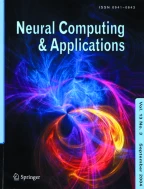Abstract
Multilayer perceptron has been widely used in time series forecasting for last two decades. However, it is a well-known fact that the forecasting performance of multilayer perceptron is negatively affected when data have outliers and this is an important problem. In recent years, some alternative neuron models such as generalized-mean neuron, geometric mean neuron, and single multiplicative neuron have been also proposed in the literature. However, it is expected that forecasting performance of artificial neural network approaches based on these neuron models can be also negatively affected by outliers since the aggregation function employed in these models is based on mean value. In this study, a new multilayer feed forward neural network, which is called median neuron model multilayer feed forward (MNM-MFF) model, is proposed in order to deal with this problem caused by outliers and to reach high accuracy level. In the proposed model, unlike other models suggested in the literature, MNM which has median-based aggregation function is employed. MNM is also firstly defined in this study. MNM-MFF is a robust neural network method since aggregation functions in MNM-MFF are based on median, which is not affected much by outliers. In addition, to train MNM-MFF model, particle swarm optimization method was utilized. MNM-MFF was applied to two well-known time series in order to evaluate the performance of the proposed approach. As a result of the implementation, it was observed that the proposed MNM-MFF model has high forecasting accuracy and it is not affected by outlier as much as multilayer perceptron model. Proposed method brings improvement in 7 % for data without outlier, in 90 % for data with outlier, in 95 % for data with bigger outlier.
Similar content being viewed by others
Explore related subjects
Discover the latest articles, news and stories from top researchers in related subjects.References
Aladag CH, Egrioglu E (2012) Advanced time series forecasting methods. In: Aladag CH, Egrioglu E (eds) Advances in time series forecasting. Bentham Science Publishers, Netherlands. eISBN: 978-1-60805-373-5. http://www.benthamscience.com/ebooks/9781608053735/preface.htm
Aladag CH, Kayabasi A, Gokceoglu C (2012) Estimation of pressuremeter modulus and limit pressure of clayey soils by various artificial neural network models. Neural Comput Appl (in press). doi:10.1007/s00521-012-0900-y
Aladag CH, Egrioglu E, Yolcu U, Dalar AZ (2012) A new time invariant fuzzy time series forecasting method based on particle swarm optimization. Appl Soft Comput 12:3291–3299
Aladag CH, Egrioglu E, Yolcu U (2010) Forecast combination by using artificial neural networks. Neural Process Lett 32(3):269–276
Aladag CH, Egrioglu E, Kadilar C (2009) Forecasting nonlinear time series with a hybrid methodology. Appl Math Lett 22:1467–1470
Basu M, Ho TK (1999) Learning behavior of single neuron classifiers on linearly separable or nonseparable inputs. In: IEEE LICNN’99
Box GEP, Jenkins GM, Reinse GC (1994) Time series analysis: forecasting and control. Prentice-Hall, Englewood Cliffs
Chaturvedi DK, Mohan M, Singh RK, Kalra PK (2004) Improved generalized neuron model for short-term load forecasting. Soft Comput 8(5):370–379
Giles CL, Maxwell T (1987) Learning invariance and generalization in higher order networks. Appl Opt 26:4972–4978
Hill T, Marquez L, O’Connor M, Remus W (1994) Artificial neural networks for forecasting and decision making. Int J Forecast 10:5–15
Homma N, Gupta MM (2002) Generalized second-order neural unit. Bull Coll Med Sci Tohoku Univ 11(1):1–6
Janacek G (2001) Practical time series. Oxford University Press Inc., New York, p 156
Kennedy J, Eberhart R (1995) Particle swarm optimization. In: Proceedings of IEEE international conference on neural networks, Piscataway, NJ, USA. IEEE Press, pp 1942–1948
Labib R (1999) New single neuron structure for solving non-linear problems. In: IEEE IJCNN’99, pp 617–620
Ma Y, Jiang C, Hou Z, Wang C (2006) The formulation of the optimal strategies for the electricity producers based on the particle swarm optimization algorithm. IEEE Trans Power Syst 21(4):1663–1671
McCulloch WS, Pitts W (1943) A logical calculus of the ideas immanent in nervous activity. Bull Math Biophys 5:115–133
Plate TA (2000) Randomly connected sigma–pi neurons can form associator networks. NETCNS Netw Comput Neural Syst 11:321–322
Rumelhart E, Hinton GE, Williams RJ (1986) Learning internal representations by error propagation, chapter 8. The M.I.T. Press, Cambridge, pp 318–362
Shi Y, Eberhart RC (1999) Empirical study of particle swarm optimization. Proc IEEE Int Congr Evol Comput 3:101–106
Shiblee M, Chandra B, Kalra PK (2010) Learning of geometric mean neuron model using resilient propagation algorithm. Expert Syst Appl 37:7449–7455
Sinha M, Kumar K, Kalra PK (2000) Some new neural network architectures with improved learning schemes. Soft Comput 4(4):214–223
Taylor JG, Commbes S (1993) Learning higher order correlations. Neural Netw 6(3):423–428
Yadav RN, Kumar N, Kalra PK, John J (2006) Learning with generalized-mean neuron model. Neurocomputing 69(16–18):2026–2032
Yadav RN, Kalra PK, John J (2007) Time series prediction with single multiplicative neuron model. Appl Soft Comput 7:1157–1163
Zhang G, Patuwo BY, Hu M (1998) Forecasting with artificial neural networks: the state of the art. Int J Forecast 14(1):35–62
Zhang CN, Zhao M, Wang M (2000) Logic operations based on single neuron rational model. IEEE Trans Neural Netw 11:739–747
Zhao L, Yang Y (2009) PSO-based single multiplicative neuron model for time series prediction. Expert Syst Appl 36:2805–2812
Author information
Authors and Affiliations
Corresponding author
Rights and permissions
About this article
Cite this article
Aladag, C.H., Egrioglu, E. & Yolcu, U. Robust multilayer neural network based on median neuron model. Neural Comput & Applic 24, 945–956 (2014). https://doi.org/10.1007/s00521-012-1315-5
Received:
Accepted:
Published:
Issue Date:
DOI: https://doi.org/10.1007/s00521-012-1315-5
